8: Costs and Performance: A Deep Dive into Our Sustainable Energy System
We’ve completed our first full heating season with the heat pump. Last time I reflected on how it felt to live with it (Blog 7). This post will detail the performance and financial implications of our heat pump, solar panels and battery storage, offering insights into the real-world efficiencies and cost savings achieved.
My data analysis spans our heating season from when we turned the heating on (27 September 2024) to 7 months later when we turned it off again (27 April 2025).
System Efficiency: Coefficient of Performance (CoP)
A critical metric for evaluating heating systems is the Coefficient of Performance (CoP), which measures the ratio of heat output to power input. Our heat pump demonstrated a Seasonal CoP (SCoP) of 4.03 for heating only. This is a significant improvement over our old gas boiler, which had an estimated SCoP of 0.85, making the heat pump approximately 4.75 times more efficient. For domestic hot water, the CoP was 3.18.
Here is a graph showing how the performance and power requirements varied through the season:
It is worth noting that current government models still often use a CoP of 3.0 for heat pumps, a figure that appears notably low when considering the performance of modern R290 heat pumps, including ours. And don’t believe the myths - remember that our house is mostly solid brick with an EPC rating of just D, and we didn’t replace any radiators or pipework!
Energy Pricing and Consumption
Prior to the heat pump we were on Octopus's Flexible tariff, where electricity was priced at 27.7p/kWh plus a 46.7p daily standing charge, and gas at 6.9p/kWh plus a 31.1p daily standing charge (both with 5% VAT to be added). This made electricity approximately 4.01 times more expensive per unit than gas. On this standard tariff, the higher efficiency of the heat pump would have still resulted in a marginally cheaper running cost, primarily due to the elimination of the gas standing charge offsetting the slightly more expensive hot water production.
As you can see, it is only when the external temperature dropped below 4.5c did the COP fall below the breakeven point of 4.01. Notice also how few days there really are when the heat pump was more expensive than a gas boiler.
Over the 7-month heating season, our heat pump consumed a total of 4281kWh, averaging 20kWh per day (including hot water as well as heating). Our total household electricity consumption during this period was 8061kWh, with no gas obviously as it’s been disconnected!
The Impact of Battery Storage and Solar Generation
What a difference battery storage and solar panels have made to our energy consumption patterns and costs. Our battery capacity of 27kWh comfortably exceeded the average daily heat pump requirement of 20kWh. Only on 62 days (29%) did the heat pump's power requirement exceed our battery storage - coincidentally around the 4.5c level.
To optimise costs and environmental impact, we switched to the Octopus Go tariff. This gives 5 hours of off-peak charging at 8.5p/kWh overnight, but with a slightly increased peak rate. This off-peak rate is roughly 30% of the standard tariff cost.
Throughout the heating period, we only required peak-priced electricity on 57 days (27%). Of our total power requirement, only 548kWh was purchased at peak rates (7%). The vast majority of our electricity came from off-peak charging (6963kWh = 86%) and our solar generation (550kWh = 7%).
We also actively managed our energy by exporting any excess power back to the grid in the late evening before refilling our batteries overnight with off-peak electricity. During this period, we exported a total of 1553 kWh at a rebate rate of 15p/kWh. This represents clear profit for excess solar generation, and even for off-peak imported electricity that was later exported, it resulted in a gain of 6.5p/kWh (15p - 8.5p). Our average electricity cost (after accounting for exports) was just 6.2p/kWh, inclusive of the daily standing charge and VAT. This is lower than the cost of gas!
Here’s a chart of the daily total power cost compared to the external temperature:
Financial Savings
The financial benefits of our sustainable energy system have been substantial. Our total expenditure on power over the 7-month heating season was £649. This compares to an estimated £2,361 if we had continued to rely on our gas boiler, an expected saving of £1,712 for the heating season alone.
From the beginning of April, our daily electricity cost has been a net credit due to solar generation and strategic export. Looking ahead to the summer months, we anticipate a net electricity bill of -£569, a significant contrast to the £834 combined electricity and gas bill we’ve seen over the past two summers.
This leads to an estimated total annual saving of £3,115 from our sustainable energy set-up.
Investment and Payback Period
The upfront investment was considerable. After deducting the £7,500 government Boiler Upgrade Scheme grant, the net installed cost of the heat pump was £11,000. The solar panels and battery storage were an additional £25,000. This totals £36,000, yielding an initial estimated payback period of 11.5 years.
However, this payback period is projected to decrease dramatically due to two key factors:
Rebalancing of Green Levies: The government is anticipated to announce the shift in policy costs or green levies from electricity to gas later this year. This change is expected to reduce the ratio of electricity to gas pricing from nearly 4.0:1 down to 2.4:1
(see Nesta).Decreasing Wholesale Electricity Prices: UK government projections (see Cornwall Insight) indicate that significant investment in renewable energy and storage will lead to a reduction in wholesale electricity prices by over 50% by 2030. The Statista graph below shows the projected cost by year - the left circled years are 2023-2025 and the right circled are 2030-2032:
Considering these two forthcoming changes, I think our investment payback will be virtually complete by 2031, within approximately 6 years.
Let me know what you think or have any questions. At the end of the summer I will do a similar review of the solar season.


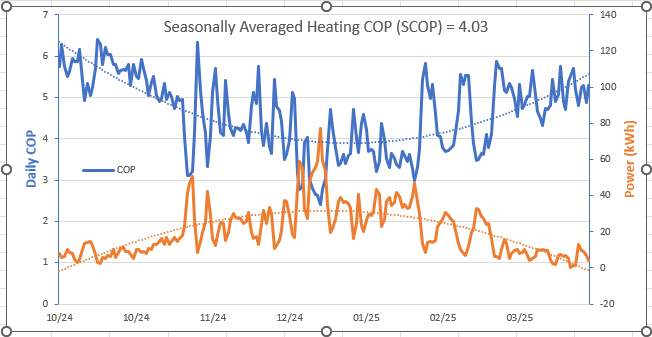
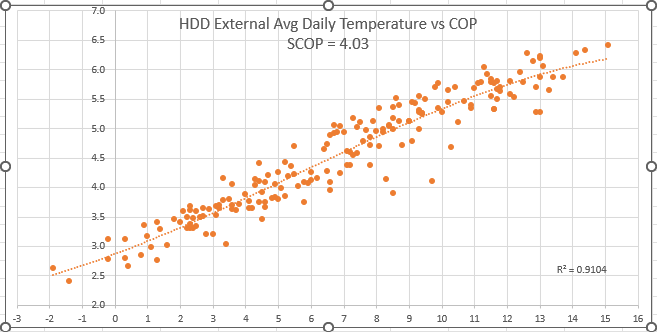
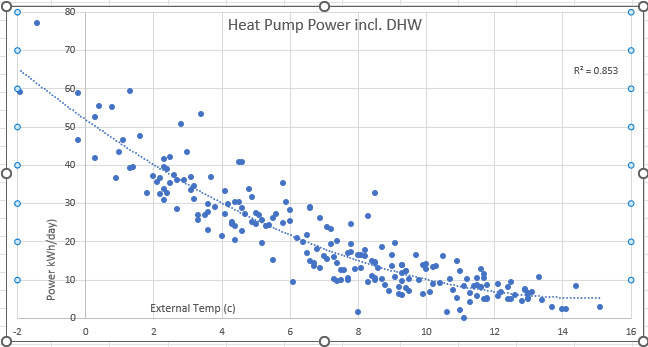
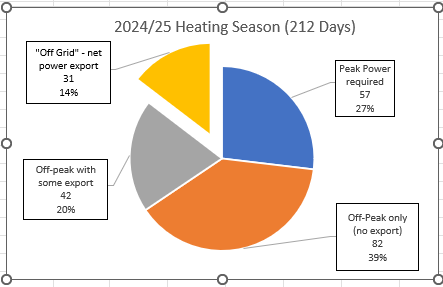
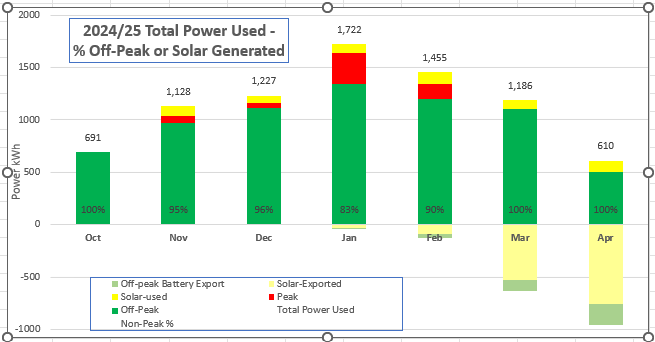
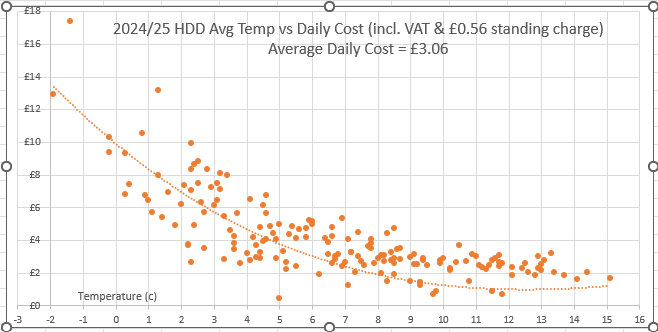
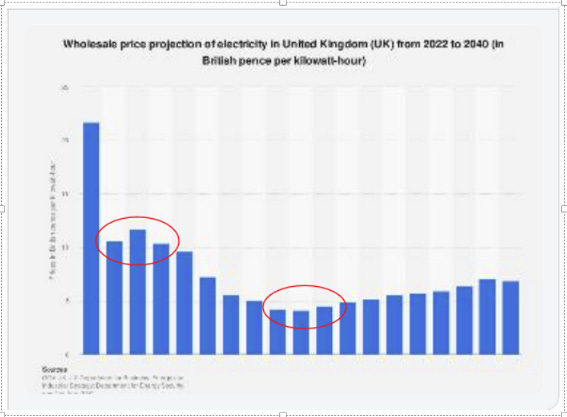
So thats 18.5k for the heat pumps setup and alterations excl the BUS grant? What would the payback be if it was a heat pump only installation?
Out of interest, you have quoted the total costs as being £36k. Does this include the cost of removing the chimney ? I'm hoping yes since the only reason to remove the chimney was for improved solar generation.
I also read in one of the other blogs that you had underfloor insulation installed. Is this cost included in the £36k ? It is also worth stating that having this additional insulation would have resulted in a reduction in your heating costs if you'd stuck with you gas boiler, therefore the direct comparison of running cost savings are not really correct.
It is worth keeping in mind that the economics of this type of setup are very dependent on there continuing to be good overnight electricity tariffs, and good electricity export tariffs - the current Octopus flat 15p/kWh export is unsustainable, and will likely be revised down significantly within the next 12 months.
All this said, I am very impressed with what you have done. Even without the solar and batteries you'd have improved heating with similar running costs to your existing gas boiler, and you are demonstrating perfectly that this type of house can work just fine with a heat pump without massive upgrades to anything existing. A very different message to that being run by the popular media.